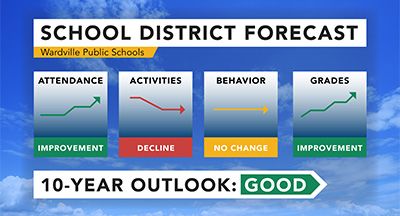What is Decaying Average?
#Achievement
Erin Werra
by
Erin Werra

|
Erin Werra Your Average Reporter |

|

|

|
 |
In general, once parents come to terms with the end of the letter grade, standards are fairly easy to communicate because they offer a clear, measurable point of knowledge. It’s easy to identify where students struggle, and where they excel. Standards provide students with a clear goal to work toward in order to achieve proficiency—because either you’ve mastered a standard, or you haven’t, right?
Not so fast.
Proficiency’s counterpart, growth, is important to this equation too. Performance to standard may be an indicator of where the student has arrived, but it doesn't tell us anything about where they came from. Did the mastery of a certain standard represent a significant climb, or was it something the student already achieved before setting foot in the classroom? How can we know for sure?
Growth and Decay
Though the word "decay" sounds a bit oxymoronic, many believe the best way to measure growth is to apply a weighted, or decaying, average. It gives greater weight to the most recent scores, rewarding students for how far they've come without punishing them for where they started.In contrast to more complicated methods, Decaying Average uses relatively straightforward formulas to calculate a student's level of mastery using a weighted average. It’s easy enough to calculate by hand or via Excel in a pinch, though the expectation is that most online gradebooks and/or student information systems should have the programming done at this point.
When calculating grades, each new score is given a higher weight than the previous scores’ weighted average. A typical equation for decaying average using a 65% weight looks like this:
Score 1: 4
Score 2: 3
Grade calculation: (4*.35) + (3*.65) = 3.35
A student completes a third assignment. Then, the equation takes the previous average and adds the weighted new score like so:
Score 3: 3.5
Grade calculation: (3.35*.35) + (3.5*.65) = 3.45
The decision to use Decaying Average assumes students' abilities will increase with practice, and errors will decrease with sufficient instruction and support. The calculation focuses on representing the growth occurring, which lends a good balance to proficiency and growth in grading.
Plus, the Decaying Average allows teachers flexibility in weighting assignments and in the formula overall. District leaders can choose, for example, to weight assignments by 60%, 65%, or 70% throughout the district or school.
Critics of the Decaying Average worry students will think it's okay to be lazy when the semester begins, ultimately resulting in lower growth overall—however, these types of worries about motivation reflect more on the culture of the school and student accountability than the method used for grading.
Other Weighted Average Methods
Decaying Average isn’t the only option out there for weighting grades. The complex formula known as Power Law is backed by Robert J. Marzano’s research in his book Transforming Classroom Grading. It’s a predictive calculation which answers the question, What score would this student most likely receive on the standard if assessed again?Power Law has a few quirks for district leaders to consider:
- It relies on a complex, difficult-to-explain equation.
- Its results will occasionally end up being lower than the student's highest historical score due to the way the formula represents evidence of growth, which can be frustrating to students and parents.
- It requires at least three scores from separate dates to work.
- It does not give teachers control over any of the weight of assignments.
Next, district leaders may consider Most Recent Score. Aside from having the least dramatic name, this method offers a simpler way to grade. Assuming students master each skill or standard, the new scores they achieve should increase. Teachers simply use the most recent score earned to carry all the weight of determining the overall grade.
Most recent score:
- Fails to consider the value of any previous scores in order to quantify growth.
- Works better with skill-based standards rather than content-based standards.
- Risks inaccurately portraying proficiency by basing it on a single score.
Finding Balance
It’s possible to demonstrate growth and proficiency in standards-based grading using a weighted average. Decaying Average offers district leaders a way to effectively weight grades without relying on a formula too complex to explain. It places higher importance on growth from more recent scores and gives teachers flexibility to weight grades.Any method of grading that doesn’t look like alphabet soup is bound to raise at least a few eyebrows. Remember to keep the conversation open—and weigh your options carefully.
For more on the evolution of grading, check out Is This the End of Grades?

|
Erin Werra Your Average Reporter |
|
|

|

|

|
 |










